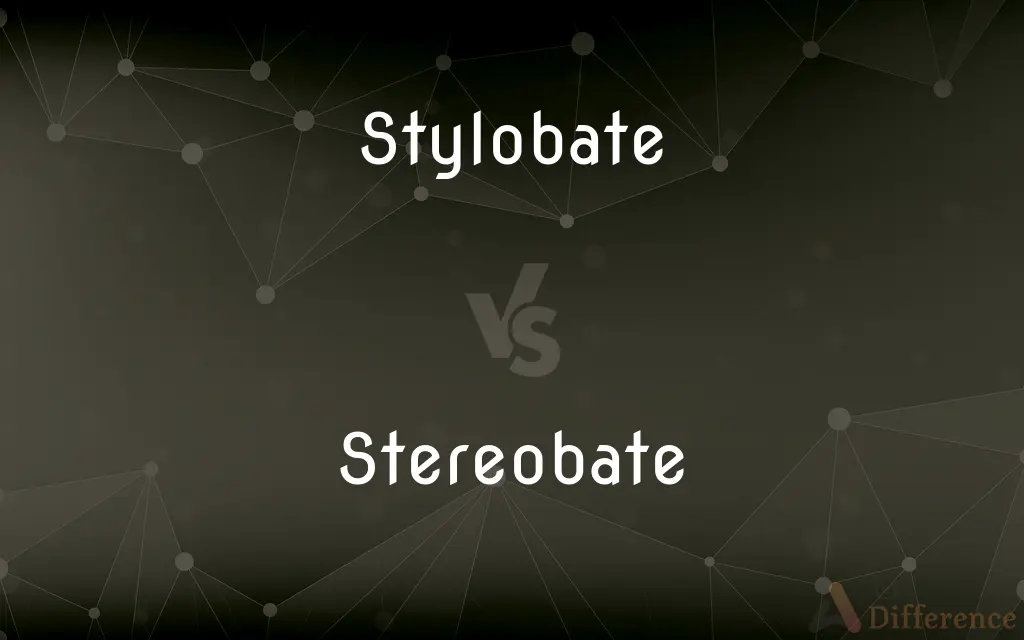Stylobate vs. Stereobate — What's the Difference?
Edited by Tayyaba Rehman — By Urooj Arif — Updated on April 14, 2024
Stylobate refers to the upper platform of classical temples supporting columns; stereobate forms the foundation steps under the stylobate.

Difference Between Stylobate and Stereobate
Table of Contents
ADVERTISEMENT
Key Differences
In classical architecture, the stylobate is the visible upper platform on which columns are erected, directly influencing the temple’s aesthetic and structural integrity. In contrast, the stereobate serves as the substructure or series of steps that form the foundation for the stylobate, typically less visible but crucial for stability.
The stylobate is usually a flat surface, meticulously leveled to ensure the columns stand perfectly vertical for both optical appeal and architectural soundness. On the other hand, the stereobate often consists of multiple layers of steps or blocks, which may be partially buried or less finished, as they are primarily functional.
Architecturally, the stylobate directly interacts with the superstructure of a temple, including columns and entablature. Whereas, the stereobate interacts more with the ground, ensuring the entire structure above remains level and supported.
Visually, the stylobate is often carefully crafted and can be seen as part of the aesthetic and sacred space of the temple. Conversely, the stereobate, while essential, is generally more utilitarian in appearance and less frequently adorned.
From a construction perspective, the precision in the construction of the stylobate is critical, as any error can lead to structural problems in the columns or the entablature. Meanwhile, the stereobate needs to be strong and robust, with a focus on supporting weight and withstanding the pressures of the earth.
ADVERTISEMENT
Comparison Chart
Definition
Upper platform in classical temples for columns
Foundation steps supporting the stylobate
Function
Supports and aligns columns
Provides a stable foundation for the stylobate
Visibility
Highly visible and part of the temple’s aesthetics
Less visible, mostly concealed beneath the stylobate
Importance in Structure
Critical for vertical alignment of columns
Essential for overall stability of the structure
Aesthetic Contribution
Often ornately finished and visible
Functional, rarely ornate, usually not visible
Compare with Definitions
Stylobate
The upper platform in classical temples that supports the columns.
The Parthenon's stylobate is remarkably horizontal, with only a slight curvature.
Stereobate
Functions primarily to support and stabilize the stylobate.
Without a solid stereobate, the temple could suffer structural failure.
Stylobate
Is the immediate base for the temple's columns.
Each column on the stylobate was carved to fit perfectly.
Stereobate
Typically not meant to be visible or decorative.
The stereobate layers were mostly buried under the ground.
Stylobate
Directly influences the temple’s visual harmony and symmetry.
Any deviation in the stylobate could misalign the entire column structure.
Stereobate
More about function than form.
The builders prioritized the strength of the stereobate over its appearance.
Stylobate
A critical element in the optical and structural perfection of ancient architecture.
Architects checked the stylobate's levelness with precise tools.
Stereobate
The foundation steps or blocks beneath the stylobate in classical temples.
The stereobate was constructed with multiple layers to ensure stability.
Stylobate
Part of the temple’s aesthetic appeal.
The stylobate was finished with fine marble to enhance the temple's beauty.
Stereobate
Essential for distributing the weight of the temple above.
The stereobate's design helped distribute the heavy load of the columns.
Stylobate
In classical Greek architecture, a stylobate (Greek: στυλοβάτης) is the top step of the crepidoma, the stepped platform upon which colonnades of temple columns are placed (it is the floor of the temple). The platform was built on a leveling course that flattened out the ground immediately beneath the temple.
Stereobate
See stylobate.
Stylobate
The immediate foundation of a row of classical columns. Also called stereobate.
Stereobate
The foundation of a stone building, its top course sometimes being a stylobate.
Stylobate
The top step of the crepidoma, i.e. the platform upon which the superstructure of the building is erected.
Stereobate
The foundation, typically of a stone building.
Stylobate
The uninterrupted and continuous flat band, coping, or pavement upon which the bases of a row of columns are supported. See Sub-base.
Stereobate
The steps of the platform beneath the stylobate.
Stereobate
The lower part or basement of a building or pedestal; - used loosely for several different forms of basement.
Common Curiosities
What is the purpose of the stylobate?
To support and perfectly align the columns of a temple.
Can you see the stereobate in classical temples?
Typically, the stereobate is less visible as it's often beneath the stylobate.
What is a stereobate?
It is the series of foundation steps or blocks that support the stylobate.
Why is the leveling of the stylobate important?
Leveling is crucial to ensure that the columns erected on the stylobate are vertical and stable, which is vital for both the aesthetic symmetry and structural integrity of the temple.
Do all classical temples have a stylobate and stereobate?
Most classical Greek and Roman temples feature both a stylobate and stereobate, though their design and prominence can vary based on architectural style and era.
How does the stereobate affect the longevity of a temple?
A well-constructed stereobate ensures a stable and durable foundation, which significantly contributes to the longevity and integrity of the temple structure.
What happens if the stereobate is not properly constructed?
Improper construction of the stereobate can lead to foundational issues, uneven settling, and long-term structural damage to the temple.
Are there any famous examples of temples with distinctive stylobates?
The Parthenon in Athens is famous for its slightly curved stylobate, designed to counter optical illusion and ensure the structure appears straight and balanced from a distance.
What is a stylobate?
It's the upper platform on which columns of classical temples are erected.
How does the stereobate contribute to the stability of a temple?
It provides a solid, leveled base that supports the stylobate and the entire structure above.
What materials are used to build a stylobate?
Stylobates are typically constructed from durable stone materials such as marble or limestone, chosen for their structural and aesthetic qualities.
Can the design of the stereobate vary between different temples?
Yes, the design and number of layers in the stereobate can vary depending on the size, style, and geographical location of the temple.
Is the stylobate level or does it have a slope?
The stylobate is generally level, though some ancient examples like the Parthenon have a slight curvature for optical refinement and water drainage.
How is the stereobate constructed in terms of engineering?
The stereobate is engineered with multiple layers of stone or blocks, each layer carefully measured and constructed to distribute weight evenly and provide a level base for the stylobate.
What is the relationship between the stylobate, stereobate, and the overall design of a temple?
The stylobate and stereobate are integral to the design of a temple, determining its structural foundation and the visual and spatial arrangement of the columns and superstructure, respectively. They work together to achieve both stability and aesthetic harmony in the temple’s architecture.
Share Your Discovery

Previous Comparison
Intolerance vs. Tolerance
Next Comparison
Interval vs. StepAuthor Spotlight
Written by
Urooj ArifUrooj is a skilled content writer at Ask Difference, known for her exceptional ability to simplify complex topics into engaging and informative content. With a passion for research and a flair for clear, concise writing, she consistently delivers articles that resonate with our diverse audience.
Edited by
Tayyaba RehmanTayyaba Rehman is a distinguished writer, currently serving as a primary contributor to askdifference.com. As a researcher in semantics and etymology, Tayyaba's passion for the complexity of languages and their distinctions has found a perfect home on the platform. Tayyaba delves into the intricacies of language, distinguishing between commonly confused words and phrases, thereby providing clarity for readers worldwide.














































